Art tourism offers travelers a unique way to explore destinations, emphasizing art and cultural experiences. Creative tourism combines artistic appreciation with visits to historic sites, galleries, and local landmarks. By engaging with art in these settings, travelers contribute to the preservation of cultural spaces that might otherwise face neglect. This tourism delivers a sustainable, immersive experience, allowing travelers to explore while giving back to local communities.
Revitalizing Historic Sites and Cultural Spaces
This tourism model brings attention and resources to cultural sites that may lack funding. Tourists participate in workshops, attend live performances, and enjoy cultural events that showcase local traditions. These activities bring life to places like small towns or underfunded historic sites, which often struggle to attract visitors. The increased attention funds restoration efforts and sustains local economies, ensuring these destinations thrive.

Bernd 📷 Dittrich | Unsplash | Art tourism brings attention and resources to cultural sites that may lack funding.
Art Tourism and Economic Growth
Art tourism supports local economies, especially in rural areas. By focusing on culture and heritage, these destinations attract visitors who, in turn, support small businesses, artisans, and local organizations. This tourism provides a steady income stream for community members while keeping cultural traditions alive. The local economy benefits through increased tourism, which creates jobs and nurtures vibrant, sustainable communities.
For example, small towns across Europe have tapped into their unique cultural assets to boost economic growth. Local markets, art festivals, and exhibitions attract tourists, filling local hotels and restaurants. This boost supports job creation and offers sustainable economic opportunities, helping these areas thrive.
Global Examples of Art Tourism
Art tourism isn’t limited to one region; it’s a global movement. Many countries are leveraging their artistic heritage to create memorable travel experiences. In Spain, the Proyecto Armazón initiative has revitalized historic castles, transforming them into venues for art exhibitions. These exhibitions align with the 17 United Nations Sustainable Development Goals, merging culture and environmental awareness. The initiative preserves historical structures while also promoting social causes through art.
In other regions, similar projects are reshaping tourism. Travelers flock to places where they can meaningfully engage with art, from public art installations to interactive exhibits. These experiences help connect people with local culture and build a sense of appreciation for different art forms. As art tourism spreads, it creates a platform for global artistic expression, sparking interest in diverse cultural traditions.
Recognizing Authentic Art Tourism Ventures
While art tourism offers significant benefits, not every project genuinely supports community goals. Some ventures may use art as a mere attraction, focusing on profit over cultural preservation. These commercially driven projects might prioritize sales rather than fostering sustainable community development. It’s essential for travelers to distinguish between authentic art tourism initiatives and those primarily interested in financial gain.
Genuine art tourism projects prioritize non-profit goals, environmental preservation, and cultural enrichment. They aim to educate and inspire while preserving the local heritage. By supporting these ventures, travelers contribute to a positive impact on the places they visit. This ensures that tourism benefits both local communities and the environment, creating a sustainable future for art tourism.

@travellookeasy | Instagram | Genuine art tourism aims to educate and inspire tourists while preserving the local heritage.
The Role of Art Tourism in Sustainable Development
Art tourism is vital to sustainable development, especially in rural and less-populated areas. These regions generate revenue that supports conservation and cultural preservation efforts by attracting tourists. Art tourism fosters a connection between travelers and the places they visit, emphasizing cultural respect and sustainable practices. This approach benefits both the environment and the community, creating a cycle of support that sustains cultural heritage for future generations.
In many ways, art tourism enriches both travelers and local residents. It offers a rewarding experience that combines creativity with historical preservation. Visitors can explore new destinations as a sustainable travel option while actively supporting the people and places that make these experiences possible. Art tourism, therefore, offers a unique, sustainable travel experience that bridges creativity, culture, and conservation.
This tourism goes beyond simply viewing art; it represents a form of travel that values cultural engagement and environmental responsibility. Travelers can positively impact the world by choosing art tourism, ensuring that cultural sites continue to inspire and educate for generations to come.






